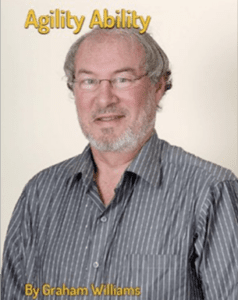
Guest post by Graham Williams.
We live in a sea of changes. Many have written of accelerated change in modern times. They come from all sides. Businesses face more unpredictable events stemming from within and from without:
- political, ecological, religious fundamentalism, social, financial and economic – which all feed off each other
- natural disasters, war, food and water shortages, extreme poverty, protesting communities, jittery markets, are all volatile events that can quickly escalate into crises.
- sudden, rare, unexpected, seriously disruptive events termed ‘Black Swans’ by Nassim Nicholas Taleb
- the possibility of being taken unawares by slow, creeping, imperceptible threats that we don’t perceive until it’s too late (the boiling frog syndrome)
Chronic uncertainty has become the new norm. How can we develop agility ability? The search is on for early detection of change threats (and opportunities), followed by effective diagnosis and action, in order to ensure business continuity and success.
“Everything is foreseen except, naturally, what is going to happen” – Rene Lardeit de Lacharriere
A man walking home late one night saw Nasrudin on his hands and knees under a street light, desperately searching for something.
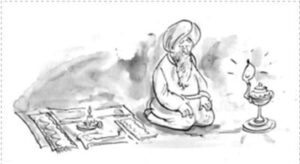 “What are you looking for?” he asked.
“What are you looking for?” he asked.
“My house key“, replied Nasrudin.
“Do you have any idea where you may have lost it?”
“Yes. In my house”.
Taken aback, the man asked, “But then why are you looking for it here?”
“Because,” said Nasrudin, “there is more light here than inside my house”.
In our search for organizational agility, we need to know what we’re looking for, where we might find it – and where not to look.
What are we looking for?
We need to reclaim the word agility as part of our vocabulary. A working definition: Agility is the ability to detect, assess and respond to unexpected and threatening events (which may also be an opportunity) both quickly and appropriately. This presupposes collaboration and communication throughout the process, and the underlying characteristics of calm, mindfulness, adaptability, innovation and resilience.
This is not a new competence. Organizations have always needed to have their finger on the customer pulse, quickly develop new products, and be quick to market. Most firms have also developed contingency disaster recovery processes that ‘kick in’ immediately when needed, to ensure their continuity and sustainability.
What is new is the level of agility competence now required along the entire business chain.
Where might we find it?
The research and experiences I have come across or read about suggest that we might find keys to unlocking agility in:
- organization structure
- processes and technology
- people
- culture.
ORGANIZATION STRUCTURE
Clearly agility and bureaucratic, command and control, hierarchical organizations (where decisions are made by committees and rules abound) do not go hand in hand.
The nearest that members of such organizations ever get to experiencing agility is when they are able to escape for a while into a small, satisfying project team that works outside of the normal silos. They may experience meaning, connection, shared purpose, the sharing of skills and accountability, problem-solving and decision-making flexibility. In the team they might be able to form, storm, norm, perform with freedom. They become agile and independently cope with more complexity.
This suggests that it is the absence of structural impediments, the letting go of the reins by leaders, that promotes agility and innovation. Certainly this was the Semco experience. Ricardo Semler, who inherited Semco in 1980, talked about his ‘wisdom revolution’ in his book Maverick: “We’re just a living experiment in eliminating boredom, routine, and exasperating regulations – an exploration of motivation and passion to free workers from corporate oppression. Our goal is helping people tap their ‘reservoir of talent’ and find equilibrium among love, liberty and work.”
Developed by Harrison Owen, Open Space Technology supports a structure-free container to solve issues. “A strong point of Open Space Technology is its ability to unite groups of enormous diversity in terms of education, ethnicity, economics, politics, culture, social position, or all of the above”. It works best when these conditions are present:
- A real business issue that people care about that it is something worth talking about.
- Mind numbing complexity, which no single person or small group fully understands or can solve by themselves
- High levels of diversity, in terms of the skills and people required for a successful resolution (far-reaching, boundless).
- Passion and real or potential conflict which implies that people genuinely care about the issue.
- A real sense of urgency, meaning the time for decisions and action was ‘yesterday’.
The entire organization becomes one big, agile team in an “open space” where they gather. People are invited to bring forward issues or problems – and anyone who feels attracted to that topic can join them in a group to start exploring and solving that issue. Open Space Technology may be employed from time to time in any organization (no matter how structured) faced with a complex threat or crisis.
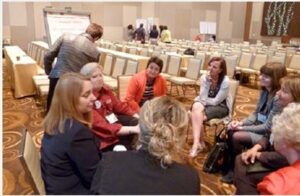
Wikipedia states: “One type of enterprise architecture that supports agility is a non-hierarchical organization without a single point of control. Individuals function autonomously, constantly interacting with each other to define the vision and aims, maintain a common understanding of requirements and monitor the work that needs to be done. Roles and responsibilities are not predetermined but rather emerge from individuals’ self-organizing activities and are constantly in flux. Similarly, projects are generated everywhere in the enterprise, sometimes even from outside affiliates. Key decisions are made collaboratively, on the spot, and on the fly. Because of this, knowledge, power, and intelligence are spread through the enterprise, making it uniquely capable of quickly recovering and adapting to the loss of any key enterprise component”.
Lars Kolind, Chief Executive of advanced hearing aid manufacturer Oticon did exactly that – way back in 1991! Turnover and profit soared. But over time, some of the old structures and rules crept back. Oticon now seem to have found a middle road.
PROCESSES AND TECHNOLOGY
It’s natural to look for agility solutions in methodologies, processes, and technology. Can we improve our readiness and response-ability by HOW we do things?
In her book “Scenario Planning: managing for the future” Gill Ringland’s concludes that “…in a time of uncertainty, it (scenario work) unfreezes intellect, allowing intelligent people a framework within which it’s not only OK, but even mandatory, to admit that they do not know what the future will bring, but nevertheless to plan. The role of vivid image, story-line, timelines and anecdotal events in scenario are an important part of the method”. Scenario conversations help people to prepare for whatever the future may be. They serve as a catalyst to broadening people’s thinking and focusing it on the future.

This helps to build confidence and is also a way to start developing a nimble, quick-response capability. “Contemporary brain/mind researchers show the important relationship between vision-building capabilities and the ability to handle complex tasks. Evidence grows that the farther into the future a brain can see itself functioning the more competent that brain is at handling complexity, juggling multiple responsibilities and integrating tasks” – say Lynch & Kordis in “Strategy of the Dolphin: scoring a win in a chaotic world”.
Today’s technologies help promote business agility, doing everything faster and with more flexibility –our interface with social media and the Internet demand a 24/7 agility in all that we do.
PEOPLE
In scanning the people factor in our search for keys to agility, let’s consider two dimensions:
- a person as an analogy or metaphor for the organization
- leveraging people power to improve agility.
The organization as a persona
People are unconsciously positively and negatively conditioned by repeating behavior cycles. They may also have a predisposition to either ‘fight or flight’ when threatened in certain circumstances. The same situation may contain both danger and opportunity. Different people may perceive and respond to the same situation in radically different ways.
Two monks are doing a walking meditation together, one of them smoking, explaining that he obtained permission from the abbot.
The other who is also a smoker, exclaims: I don’t understand. I asked the abbot if I could smoke while I meditated and his answer was an emphatic ‘no!’’
“Ah” says his companion, puffing away, “I asked him if could meditate while I was smoking!”
Organizations are like people in this respect. Nassim Nicholas Taleb shows the people-organization similarity in his book “Antifragile” when he categorizes ‘something or someone’ as either fragile or robust (anti-fragile) in their response to random shocks – with the latter being something or someone “who is more than just adaptable, resilient or robust and they don’t just endure shocks and change, they benefit from them and actively seek them out”.
 As we know, the Chinese character for crisis is: dangerous + opportunity.
As we know, the Chinese character for crisis is: dangerous + opportunity.
Here are three agility traits that apply to both individuals and organizations. These have been identified as the core characteristics of survivors:
- a clear focus on what it is they want to achieve
- an ability to experience surprises as challenges and setbacks as valuable learning experiences, refusing to be immobilized by change
- a firm sense that most of the time they are in control of their actions and in control of the meanings that they assign to events (although not in control of the events themselves).
One can easily see in these traits the veracity of vision, adaptability, positive attitude, inner locus of control, proactivity and reflection. These can all be developed with training and coaching.
Leveraging people power for greater agility
Agile responses may be required anytime. The well-known British Royal Navy seaman’s response to an order encapsulates what organizations desire: “Ready, willing and able, Sir!” It becomes possible when the organization:
- Imparts coping skills and builds change-resilience characteristics
- Creates a climate where there is self-directed learning; the sharing and building of knowledge, learning and insight
- Rewards those with the highest competency levels and results achievement for sharing their “secrets” and best practices with others (and in so doing reinforces the self-worth of those high-performers)
- Widely trains and encourages creative problem-solving and decision-making
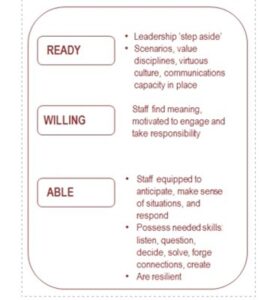
The point is that results, and adequate responses to unexpected events and crises are a function of availability, motivation, and competence:
Perhaps the strongest ability in agility is the power of mindfulness: we are able to clearly see a situation and our reaction for what it is, and respond in ways that are not automatic, conditioned, or borne of panic. The spiritual leader Osho eloquently points out that whatever situation or impulse we need to deal with, awareness is the key: “And here I am saying that there is a simple key – awareness. You cannot believe it. How can awareness, just awareness, help when nothing else has been of help? Keys are always very small; keys are not big things. A small key can open a big lock”. (From his book: Awareness – the key to living in balance).
This holds good for everything we face. In the moment, we are both involved and a detached, reflective witness. We are able to shift our perspective from knee-jerk subjectivity to the application of a non-judgmental attention that yields objectivity, and thus a more appropriate response. The role of mindfulness in agility ability is further examined below.
ORGANIZATIONAL CULTURE
Structure, technology, process, people motivation and development all have a role to play in building organizational agility. Although there is insufficient research to back this up, my instinct is that the foundation for agility is the presence of certain character virtues (embedded values and behaviors) in an organization’s culture.
A professor and an old peasant woman are discussing how it is that the world is held up in space and does not fall down.
“Well you see,” says the old woman, “the world rests on a giant plate”.
“Interesting. And what does the plate rest on?”
“On the back of a giant tortoise”.
“And what does that tortoise rest on?”
“On the back of another tortoise…”
“And what does…”
“Don’t bother your head, professor. It’s tortoises all the way down”.
I believe it’s character virtues all the way down. Everything rests on virtues – one way or another.
Consider for example (referring to the diagrams that follow) how the seven “Leonardo da Vinci virtues” (from my book) combine to address an unexpected event – personal or organizational.
The trigger may be sudden and unexpected loss of business, or at a personal level a senior manager turns on you. At both organizational or personal levels the virtuous ‘agile response mechanism’ is essentially the same.
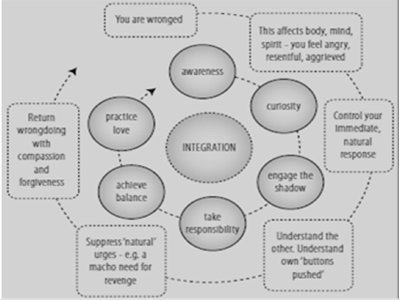
In the case that follows you are personally wronged by a colleague:
The virtue of being aware of what is happening allows you to acknowledge and identify your bodily reactions and feelings, enabling you to exercise control, and choose how you will respond.
Applying curiosity around why you experienced your initial reaction can lead to discovery of ingrained, ‘primitive brain’ reactions perhaps introduced at an early stage in your life. This is an opportunity to engage the shadow side and learn.
A sincere attempt at understanding where the other is coming from and what may be driving their behavior is also healthy – not condoning what they have done but understanding why.
You can now take responsibility for the event and its underlying causes. A part of this may be achieving balance in your response and personal make-up. Would your gut response and action have shown an imbalance – in being overly masculine or feminine?
This enables you to formulate and carry out a response that is based on practicing love (sometimes tough love) in order that the wrongdoing is met with compassion and forgiveness.
At that point, you’ve mobilized and integrated all of the virtues to stop a vicious cycle, and continue the relationship in a positive, assertive manner.
With time and repetition, such considered responses can become automatic. A way is offered of ‘mobilizing’ inherent virtues to filter out negative emotions and to engage positively. It’s a moment of being calm, observing, accessing wisdom within and responding with caution and reason before gut level reactions take over. A hostile knee-jerk reaction to a hostile provocation can be avoided. (Note that the time frame may be a period of seconds, weeks, or months).
The virtues may play out in a different sequence and in different proportions. And need not be in the same sequence as shown here.
Creative responses to change
In collaboratively solving a problem, the four creativity archetypes that Roger Von Oech discerns (in A Kick In the Seat of the Pants) are apparent in the diagram. The Explorer takes responsibility, defines the quest, gathers information, assesses, discovers patterns, and reaches insight. The Artist is immersed in intuiting, experimenting, questioning, follows ‘out of the groove’ thinking, adopts a ‘right brain’ approach, and welcomes ambiguity. Critical evaluation, testing, verifying, assessment of adverse consequences, a ‘left brain’ approach, is the role of the Judge in you or in the group. The Warrior takes up the challenge of fighting implementation battles.
It’s also easy to see the overlap with the Wallas five-stage model of creativity:
- preparation (preparatory work on a problem that focuses the individual’s mind on the problem and explores the problem’s dimensions),
- incubation (where the problem is internalized into the unconscious mind and nothing appears externally to be happening),
- intimation (the creative person gets a “feeling” that a solution is on its way),
- illumination or insight (where the creative idea bursts forth from its preconscious processing into conscious awareness);
- verification (where the idea is consciously verified, elaborated, and then applied).
Successful agile responses – doing the right thing quickly and with assurance, being open, flexible, collaborative – result from the application of virtues. Indeed: get the culture right, and the rest will follow.
This is the new AA – when we break the same patterns of response and develop our Agility Ability!
- When you think of your organization, how could you enhance agility ability? Which area would you work with first: structure, processes, people and/or culture?
- How can you enhance your personal agility ability?
Graham Williams is a certified management consultant, thought leader, business narrative practitioner and author based in Cape Town, South Africa. He can be reached at https://www.haloandnoose.com He published his book The Virtuosa Organisation: the importance of virtues for success in business, in 2014, with Dorian Haarhoff and Peter Fox.
Marcella Bremer is an author and culture & change consultant. She co-founded this blog and ocai-online.com.

This Post Has One Comment
Facing uncertainty & change through “mindfulness”, “resilience” & “virtuousness”, is my take home point. Great article…….thanks for sharing!